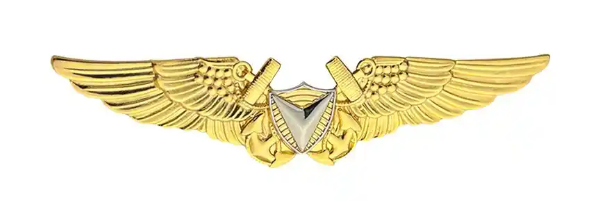
As a boy, Lt. Cmdr. Ryan Major was fascinated with flying. Not only had his great grandfather flown B-25s in WW II, two of his cousins became military pilots and his parents both worked for the airline industry. “I grew up around aviation and have always loved it,” he says.
So, Major was understandably thrilled last month when he became the first Coast Guard aerial vehicle pilot to earn his wings.
Major, an unmanned aircraft systems (UAS) aviator based in San Angelo, Texas, took the stage to receive this honor during the Robotic and Autonomous Systems (RAS) Exposition held at Coast Guard headquarters on August 26. As his parents watched from the audience, Vice Commandant, Adm. Tom Allan pinned the Navy Aerial Vehicle Pilot (AVP) insignia to his uniform.
“We are entering a new era of Coast Guard aviation where unmanned systems will play and increasingly vital role,” Allan said. “So we’ve opened up MQ-9 Flight Assignments to a broader range of qualified personnel.”
To Major, the recognition marked the culmination of an aviation career he’s been building for more than 20 years. Even prior to joining the Coast Guard in 2004, Major completed civilian flight training and became a certified flight instructor. Once in, he excelled as an aviation electronics technician and got a bachelor’s degree in aeronautical science. He served as a rotary wing sensor instructor, then later earned a commission and worked at the Coast Guard Research and Development Center (RDC) and managed projects at C5 ISC.
When the Coast Guard solicited for the new insignia, Major was working as an IT/Project Management Officer. But having accumulated more than 1,500 manned civilian flight hours over his career, he knew he had the required time in the air. “I jumped at it,” he said.
To qualify for the AVP, Major also had to complete the approved Customs and Border Protection Air and Marine Operations (CBP AMO) initial MQ-9 flight training course and local training syllabus. Historically, only Coast Guard aviators have been eligible for assignment to this JPO. But because of the unique differences between manned and unmanned aircraft, this requirement was recently adjusted to allow Coast Guard members who meet the CBP MQ-9 hiring requirements to also be eligible for assignment.
Coast Guard officials determined Major’s civilian training and certifications, together with his CBP MQ-9 training exceeded the typical requirements to wear the AVP insignia. As a result, he is now designated as Coast Guard MQ-9 Aircraft Commander and assigned the AVI 13 officer subspecialty code.
“Being an MQ-9 pilot was my pathway to become a Coast Guard pilot,” says Major, noting he’s always enjoyed being part of a crew with a common mission. “I also like the interoperability aspect of working the CBP AMO.”
The AVP insignia is reminiscent of traditional aviator wings. It features an inverted delta displayed on the shield centered on two cross anchors and flanked by wings.
Establishing a new pilot insignia for UAS pilots who operate the MQ-9 paves the way for a new career path in the service and is part of a larger initiative to expand the use of robotics and autonomous capabilities across all Coast Guard missions. In July, a program executive office—the RAS PEO—was set up to accelerate the adoption of uncrewed systems (UxS) in the field as part of Force Design 2028 modernization efforts.
This rapidly evolving technology is expected to be the biggest enhancement to operations since the inception of aviation. The RAS PEO will focus on testing and acquiring unmanned aircraft, surface, subsurface, and space systems and developing a future-ready workforce equipped to use them in the field.
The Coast Guard received $24.59 billion in the spending bill the President signed in July. Some $266 million of that is earmarked to purchase as many as four MQ-9 drones to assist with migrant and drug interdictions. These long-range drones, which can operate up to 24 hours collecting intelligence in a 60-to-80-mile radius, are significant force multipliers for the Service.
-USCG-